Meldingen din er sendt.
Vi behandler forespørselen din og kontakter deg så snart som mulig.
Skjemaet har blitt sendt inn.
Mer informasjon finner du i postkassen din.


Hvis du er her, er sjansen stor for at det monolittiske systemet ditt er i ferd med å bli mer en byrde enn en ressurs. Sakte lanseringssykluser, skaleringshodepine og en rigid arkitektur gjør det vanskeligere å henge med. Jo større appen din blir, desto mer frustrerende blir den. Ny teknologi integreres ikke problemfritt, smidigheten går ned, og påliteligheten begynner å bli dårligere.
Mikrotjenester kan snu opp ned på dette ved å gjøre systemet ditt modulært, øke hastigheten på distribusjonene og la deg skalere akkurat det du trenger når du trenger det. Men her er haken: Migrering handler ikke bare om å dele opp kode. Hvis du ikke planlegger det riktig, kan du ende opp med mer kompleksitet, integrasjonsmareritt og uventede kostnader.
I denne artikkelen går jeg gjennom et veikart fra den virkelige verden for å gå fra monolitt til mikrotjenester. Ikke noe fluff - bare praktiske trinn, dyrekjøpt lærdom fra løsningsarkitektene våre og strategier som faktisk fungerer. La oss dykke ned i det.
Jeg har sett mange selskaper som tror mikrotjenester er den magiske løsningen, men som ender opp med mer kompleksitet, ødelagte arbeidsflyter og skyhøye kostnader. Og er det én ting jeg har lært, så er det at det å hoppe rett inn i den tekniske siden uten en solid plan er en rask vei til kaos.
Det er fristende å begynne å rive fra hverandre en monolitt og spinne opp tjenester, men før vi i det hele tatt rører koden, jobber vi sammen med kundene for å kartlegge hvorfor, når og hvordan migreringen skal gjennomføres. På den måten gir hvert steg fremover faktisk verdi.
Når kunder kommer til oss for å bytte fra monolitt- til mikrotjenester, spør jeg hva som driver dem til å ta denne beslutningen. Svarene varierer, men som oftest får jeg høre at det er fordi konkurrentene gjør det samme. Og det er ærlig talt ingen god grunn. Å hoppe over til mikrotjenester uten et klart mål fører vanligvis bare til mer hodebry, ikke til faktiske fremskritt.
Så spør deg selv før du tar steget:
Hvis du ikke er 100% sikker - ingen grunn til bekymring. Vi hjelper deg med å definere de viktigste måleparameterne og forretningsresultatene på forhånd, slik at hver eneste tekniske beslutning gir resultater.
Mikrotjenester gir modularitet, uavhengig skalering og raskere innovasjon. Men de er ikke noen mirakelkur. Noen virksomheter klarer seg fint med en monolitt, spesielt hvis appen deres er enkel, stabil og ikke endrer seg mye.
Tenk deg en liten ansattportal eller et lagersystem som bare en håndfull personer bruker. Hvis det fungerer bra og ikke trenger stadige oppdateringer, kan det å dele det opp i mikrotjenester bare føre til en masse kompleksitet uten noen reell gevinst.
Derfor lanserer vi ikke mikrotjenester bare for sakens skyld. I stedet ser vi på hva du spesifikt trenger, og om mikrotjenester vil gi reelle fordeler. Hvis de gjør det, er det flott - da går vi for det. Hvis ikke, finner vi en bedre løsning.
Når vi har bestemt oss for at mikrotjenester er det rette grepet, tar vi gjerne en full helsesjekk av systemet for å se hvordan alt henger sammen. Vi ser etter svake punkter, potensielle avhengighetsproblemer og hvor alle de kritiske dataene befinner seg.
Det er risikabelt å hoppe over dette trinnet. Hvis du ikke vet hva som er under panseret, kan du ved et uhell velte hele systemet som en dominobrikke. Ved å kartlegge hva som fungerer, hva som henger etter og hva som kan gå i stykker, lager vi en smart migreringsplan som tar for seg de mest kritiske områdene først, minimerer risikoen, unngår nedetid og gjør overgangen så smidig som mulig.
Nå har du sikkert skjønt at jeg ikke er tilhenger av å rive ned en hel monolitt over natten. Det er for risikabelt, for forstyrrende og vanligvis ikke verdt stresset. I stedet velger jeg en trinnvis tilnærming som gir deg raske gevinster samtidig som driften holdes stabil.
En av mine favorittstrategier er Strangler Fig-mønsteret, som lar det gamle systemet og de nye mikrotjenestene sameksistere til du er klar for full overlevering.
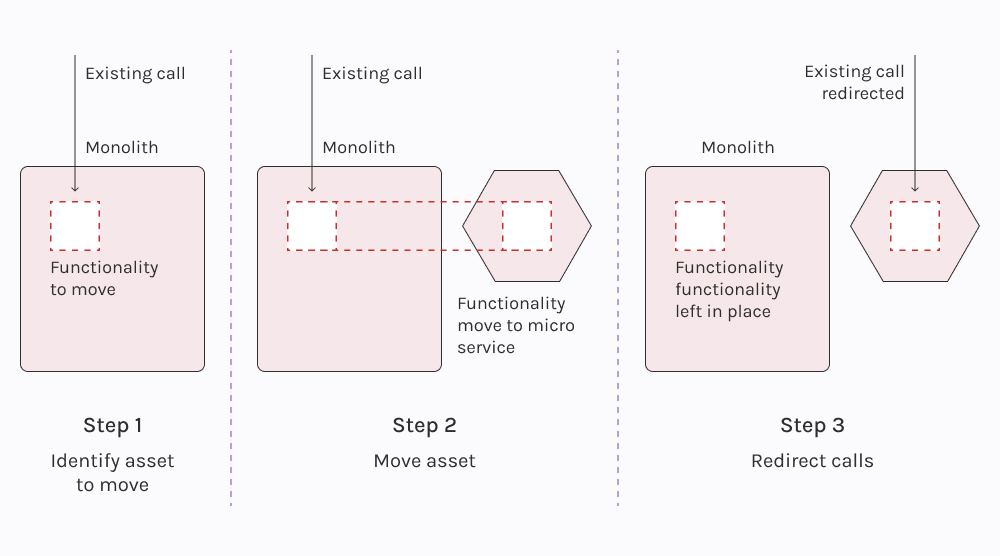
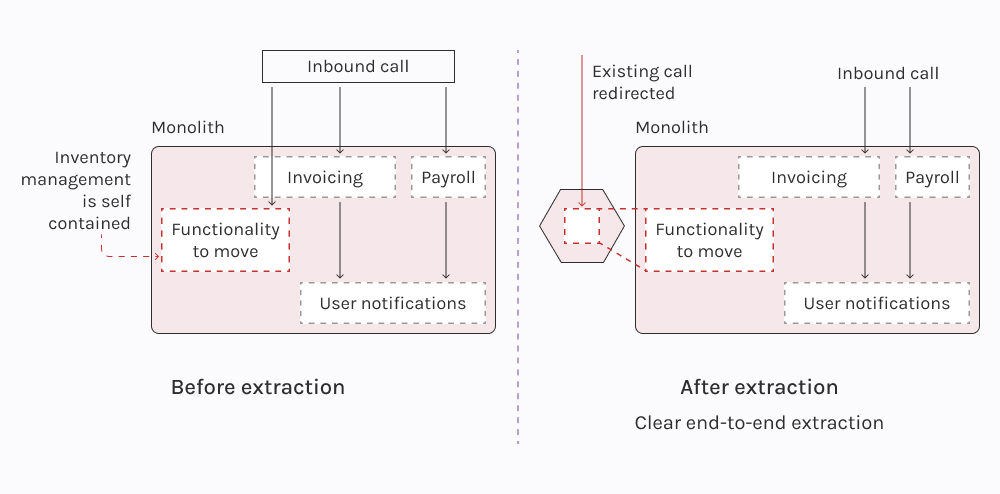
Branch by Abstraction er praktisk når du må gjøre endringer inne i selve monolitten: Vi legger til et lag, flytter komponenter én etter én og pensjonerer det gamle uten å sprenge ting i luften.
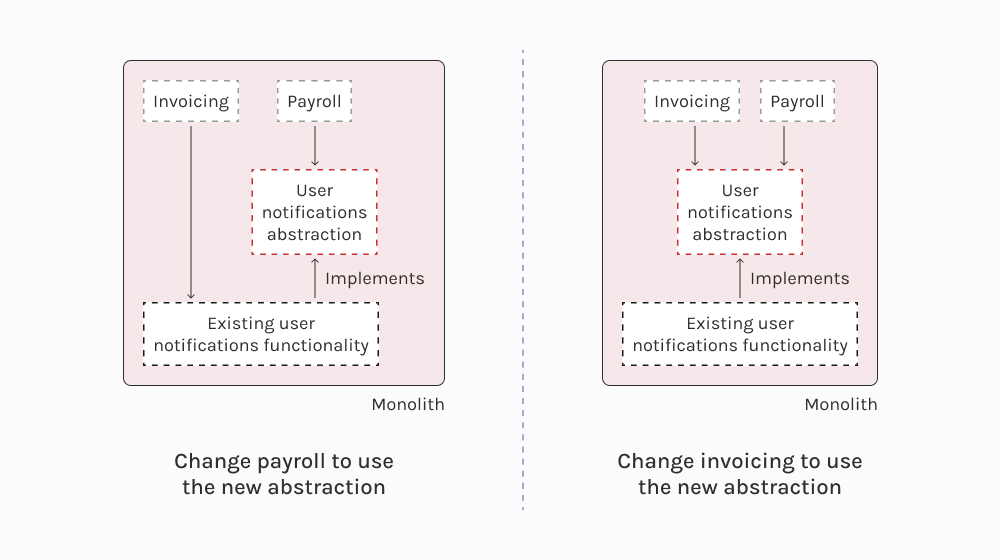
Hvis pålitelighet er avgjørende, kan Parallel Run holde begge systemene i gang og sammenligne resultatene før du setter i gang for fullt.

Og hvis du ikke kan rote med monolitten, kan du bruke Change Data Capture til å spore databaseendringer for å holde mikrotjenestene synkronisert.

Det finnes ikke én beste metode - alt avhenger av oppsettet ditt. Teamet vårt velger også ut hvilke deler som skal migreres først, og fokuserer på de delene som vil ha størst innvirkning. Ta for eksempel et kassesystem for e-handel som håndterer tusenvis av daglige bestillinger, eller en dataanalysemotor som oppdateres kontinuerlig - disse bør migreres tidlig. På den måten ser du de virkelige fordelene raskt, og holder driften i gang.
Innføring av mikrotjenester betyr også at du må riste om på måten teamene dine jobber på. I stedet for ett stort team som håndterer en monolitt, foreslår jeg å gå over til mindre, tverrfunksjonelle team der hvert team eier en spesifikk mikrotjeneste. På denne måten blir beslutninger tatt raskere, og alle vet nøyaktig hva de er ansvarlige for.
I tillegg tar ekspertene våre i bruk DevOps-prinsipper og automatisering fra dag én, slik at utrullingen av nye funksjoner går smidig og problemfritt.
"Å gå fra monolitt til mikrotjenester er ikke bare en teknisk justering - det går ut over utviklingshastigheten, systemstabiliteten og muligheten til å skalere. Uten en gjennomtenkt plan kan kostnadene skyte i været, og integrasjoner kan bli en skikkelig hodepine. Hos Innowise gjør vi overgangen smidig og effektiv, slik at du kan holde deg smidig og fokusere på å utvikle virksomheten din."

Dmitry Nazarevich
CTO
Når vi har kartlagt migreringsstrategien, er det neste store spørsmålet å finne ut hvordan vi kan dele opp monolitten i mikrotjenester uten å lage rot. Jeg har sett selskaper som enten prøver å frakoble alt på én gang eller bare velger ut tilfeldige moduler. Uansett fører det til bortkastet tid, ødelagte avhengigheter og måneder med frustrerende omarbeiding.
Min tommelfingerregel er å holde det forretningsfokusert. Det betyr at hver mikrotjeneste skal mappe til en reell forretningsfunksjon, ikke bare en tilfeldig kodebit.
En av de vanligste fallgruvene vi ser, er å dele opp en monolitt i tekniske lag. Det vil si å skille frontend, backend og database i ulike tjenester. Det er en sikker måte å ende opp med tett koblede, overdrevent pratsomme mikrotjenester som ikke skalerer godt. I stedet bruker vi domenedrevet design (DDD) og avgrensede kontekster for å bryte ting ned på en måte som faktisk gir mening.
Ta en e-handelsplattform. I stedet for å dele den opp i en generisk frontend-tjeneste og en backend-tjeneste, deler vi den opp i reelle forretningsfunksjoner som ordrebehandling, lagerstyring, betaling og brukeradministrasjon. Hver tjeneste eier sin egen logikk og sine egne data, og de er løst koblet sammen slik at de kan skaleres uavhengig av hverandre og utvikles uten at alt annet går i stykker.
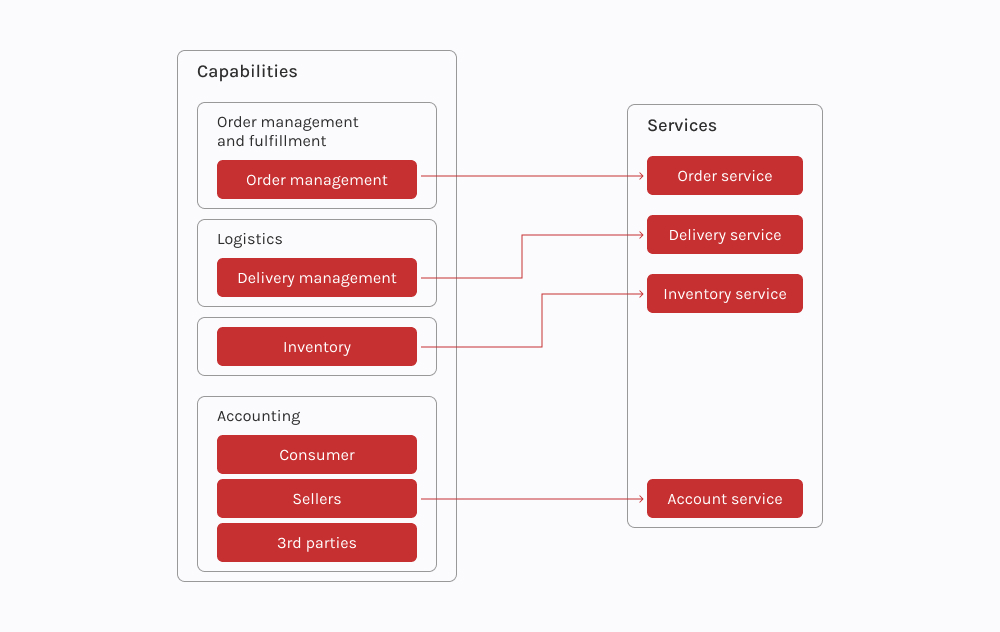
Jeg er ikke tilhenger av "big bang"-tilnærmingen. Å prøve å migrere alt på én gang er bare å be om problemer. I stedet fokuserer vi på hva vi skal bryte av først ved å se på:
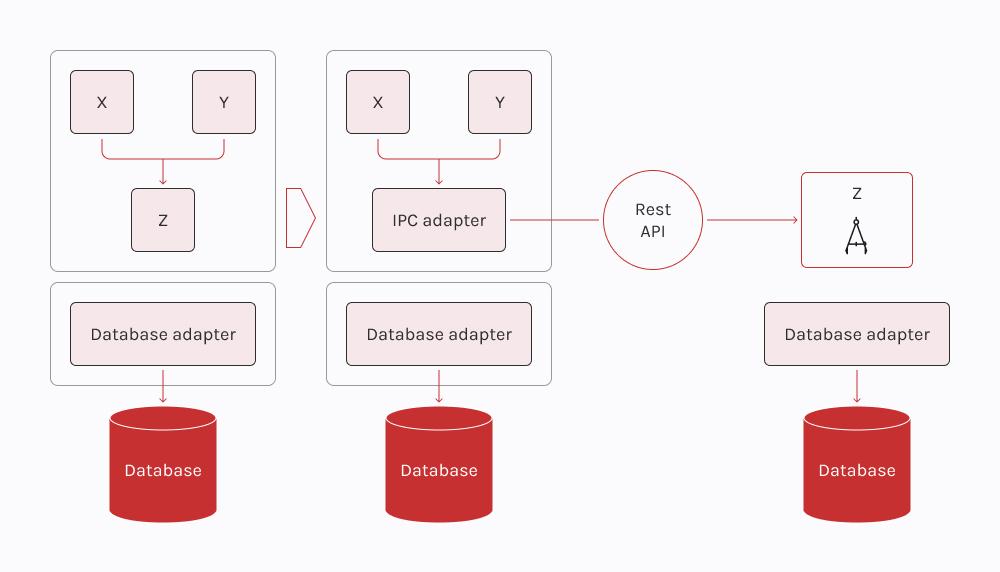
Denne tilnærmingen hjelper oss med å oppnå raske gevinster og vise verdien tidlig, noe som gjør det lettere å få støtte fra teamet. I et HR-system kan for eksempel lønnsbehandling være en god mikrotjeneste, siden den håndterer komplekse, regionspesifikke beregninger. Men en statisk bedriftskatalog? Det er sannsynligvis ikke verdt de ekstra kostnadene, og kan forbli i monolitten en stund.
Det siste vi ønsker, er å konvertere monolitt til mikrotjenester og likevel ende opp med en haug med tjenester som er for avhengige av hverandre. For å unngå dette må vi
Ved å holde tjenestene løst koblet, kan vi oppgradere eller endre dem uten å bekymre oss for å ødelegge alt annet.
Som jeg sa tidligere, kommer mikrotjenester virkelig til sin rett når hvert team eier tjenesten sin fra start til slutt. Du får raskere tilbakemeldinger, mer ansvarlighet og mye mindre frem og tilbake mellom teamene. Hos Innowise hjelper vi bedrifter med å sette opp teamene sine slik at devs, ops, QA og alle andre kan jobbe sammen på en smidig måte.
Etter at vi har delt opp monolitten i mikrotjenester, er det første spørsmålet vanligvis hva vi skal gjøre med dataene? I et monolittisk oppsett er alt knyttet til én stor database, som fungerer til den ikke gjør det lenger. I et mikrotjenesteoppsett blir den delte databasen raskt en flaskehals som bremser alt og gjør det umulig å skalere tjenestene uavhengig av hverandre.
Derfor er jeg tilhenger av en desentralisert datamodell, der hver mikrotjeneste eier sine egne data. Hvis det gjøres riktig, kan hver tjeneste vokse, tilpasse seg og skalere uten å stadig snuble over hverandre.
En massiv, alt-i-ett-database kan virke som den enkleste løsningen, men i et mikrotjenesteoppsett blir den fort en flaskehals. Hver tjeneste har ulike behov, og å stappe alt inn i én enkelt database skaper bare hindringer. Skalering blir vanskelig, avhengigheter hoper seg opp, og selv små endringer kan føre til problemer i hele systemet.
Derfor deler vi opp i mindre, tjenestespesifikke tjenester, slik at hver mikrotjeneste:
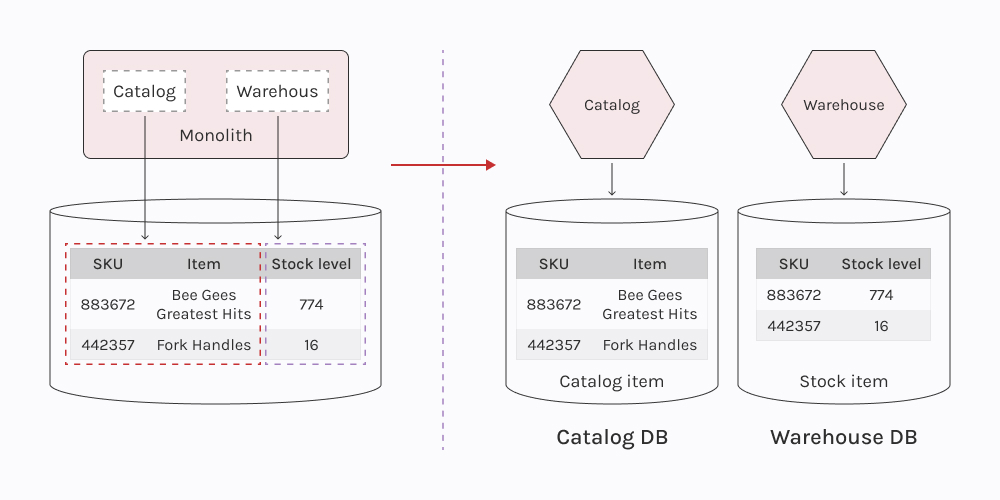
På denne måten blir alt mer fleksibelt, teamene slipper å tråkke hverandre på tærne, og man unngår flaskehalsen i databasen som bremser alle.
Flytting av data ut av en monolitt er ikke bare å slå på bryteren. Det er risikabelt å migrere uten videre, så jeg foretrekker en inkrementell tilnærming, der man bryter det ned trinn for trinn.
Vanligvis betyr det å opprette nye tabeller eller databaser for hver mikrotjeneste og holde dem synkronisert med det gamle systemet ved hjelp av CDC (Change Data Capture) eller dobbel skriving. På den måten får hver tjeneste gradvis eierskap til sine egne data - ingen nedetid, ingen ubehagelige overraskelser.
I en monolitt har du én stor, delt database og ACID-transaksjoner som sørger for at alt oppdateres (eller feiler) sammen. Men med mikrotjenester håndterer hver tjeneste sine egne data, slik at oppdateringer ikke skjer umiddelbart i hele systemet.
I stedet for direkte oppdateringer snakker tjenestene sammen gjennom asynkrone meldinger. Hvis en bestilling legges inn, sender bestillingstjenesten ut en hendelse, og lagertjenesten lytter for å justere lagerbeholdningen. Dette oppsettet sørger for at alt går som smurt, selv om en tjeneste midlertidig går ned.

Det betyr selvfølgelig at man må håndtere konsistens på en smart måte. Hos Innowise bruker vi idempotente operasjoner for å forhindre duplikater, mekanismer for nye forsøk for å håndtere problemer og dødbokstavkøer for å fange opp feil. På denne måten forblir dataene dine nøyaktige, selv når ting ikke går som planlagt.
Nå som vi har satt klare grenser for tjenesten og lagt en solid plan for datamigrering, er det på tide å brette opp ermene og omsette strategien til handling. La oss se nærmere på hvordan vi får det til.
Utviklingsteamet vårt bygger mikrotjenester ved hjelp av moderne verktøy som Spring Boot og Node.js, og sørger for at de er bygget for å skalere og håndtere utfordringer i den virkelige verden. For å sørge for at alt går som det skal, bruker vi smarte designmønstre som strømbrytere for å håndtere trafikktopper og grasiøs degradering for å forhindre kaskadefeil. På den måten kan resten av systemet ditt fortsette å kjøre uten problemer, selv om én tjeneste får problemer.
Slå av monolitten din over natten? Det kommer ikke til å skje. I stedet setter vi opp integrasjonslag ved hjelp av RESTful API-er og meldingsmeglere som RabbitMQ eller Apache Kafka for å holde de nye mikrotjenestene og de eksisterende systemene synkronisert. Disse fungerer som broer som gjør at alt kommuniserer problemfritt uten å bryte arbeidsflyten.
Og når det er fornuftig, tar vi også med API-gatewayer for å øke og sikre interaksjoner, noe som garanterer en smidig overgang uten nedetid.
Vi containeriserer mikrotjenestene dine med Docker, slik at de er raske, fleksible og enkle å administrere. Med Kubernetes som orkestreringsverktøy er det enkelt å skalere opp i travle perioder eller rulle ut oppdateringer på tvers av ulike miljøer. Dette oppsettet gjør alt konsistent, forutsigbart og kostnadseffektivt, slik at IT-operasjonene dine aldri føles som et sjansespill.
Teamet vårt setter opp CI/CD-rørledninger med verktøy som Jenkins, GitLab CI eller CircleCI for å håndtere testing, bygging og distribusjon automatisk. Ingen flere manuelle oppdateringer eller brannøvelser i siste liten. Feil blir fanget opp tidlig, utgivelser går raskere, og systemet forblir bunnsolid.
Uten de rette sikkerhetstiltakene kan selv det best utformede systemet støte på flaskehalser, uventede feil eller rett og slett krasje på det verste tidspunktet. Derfor har teamet vårt en tilnærming uten snarveier, der vi automatiserer alt og fanger opp problemer før de forårsaker reelle problemer.
Testing er ikke bare det siste trinnet, det er en del av hele prosessen. AQA-teamet vårt bruker automatiserte testpakker i flere lag for å fange opp feil tidlig, slik at ingenting går galt.
Ingen ønsker at en dårlig lansering skal ødelegge systemet, frustrere brukerne eller redusere inntektene. Derfor sørger teamet vårt for trygge, kontrollerte og tilbakestillingsklare utrullinger ved hjelp av kamptestede strategier.
La oss si at en detaljhandelsbedrift ønsker å lansere et poengbasert lojalitetsprogram, men at ordresystemet er for komplekst til at det kan endres på en trygg måte. En detaljhandelsbedrift ønsker å lansere et poengbasert lojalitetsprogram, men bestillingssystemet er for komplekst til at det er trygt å endre det. For å være på den sikre siden tester vi det først med en liten gruppe. Hvis alt går bra, ruller vi det ut bredere.
Når vi er sikre på at den grønne versjonen er solid, bytter vi over trafikken umiddelbart. Hvis noe går galt, bytter vi tilbake til blått. Null nedetid, ingen stress.
En reiseplattform ønsker for eksempel å legge til sanntidspriser, men å rote med det gamle systemet kan ødelegge bookingen. I stedet for å gå all-in, går teamet vårt blågrønt ut og sender en liten gruppe brukere til det nye oppsettet først. Hvis alt går bra, bytter vi alle over. Hvis det går galt, ruller vi tilbake umiddelbart.
Se for deg et e-handelsselskap som lanserer en AI-drevet anbefalingsmotor. I stedet for å slå på bryteren for alle, bruker vi Feature Flags til å aktivere den for tilbakevendende kunder først. Hvis engasjementet og salget øker, utvider vi, og hvis ikke slår vi den av umiddelbart.
Samtidig kjører teamet vårt A/B-tester, sammenligner det gamle systemet med det nye og sporer nøkkeltall som handlekurvverdi og konverteringsfrekvens. Disse dataene hjelper oss med å finjustere AI-en før en fullskala lansering.
Mikrotjenester produserer tonnevis av data, så det er viktig å holde øye med systemtilstanden i sanntid. Teamet vårt setter opp overvåking i flere lag med verktøy som Prometheus, Grafana og New Relic for å spore hastighet, minnebruk og feil. På denne måten kan vi oppdage problemer før de blir en hodepine. Ved hjelp av ELK Stack, Fluentd og andre samler vi også alle loggene (i bunn og grunn det digitale sporet av appene dine) på ett sted, slik at ingenting går oss hus forbi. Og hvis noe går galt, får teknikerne våre automatiske varsler så raskt som mulig.
La oss være ærlige: Ingen systemer er 100% feilsikre. Maskinvare dør, programvare krasjer og cybertrusler utvikler seg hele tiden. Derfor er databeskyttelse et must. Derfor setter teamet vårt opp automatiserte strategier for sikkerhetskopiering, slik at kritiske data forblir trygge og enkle å gjenopprette.
Migrering fra monolitt til mikrotjenester er ikke bare en engangsoppgradering, de trenger kontinuerlig vedlikehold for å yte sitt beste. Vi er her i det lange løp og garanterer at oppsettet ditt forblir fleksibelt, skalerer problemfritt og håndterer selv de tøffeste belastningene.
Teamet vårt holder et øye med hver mikrotjeneste, justerer koden, optimaliserer databasespørringer og utjevner hvordan tjenestene kommuniserer slik at alt går raskt.
Ved å analysere trafikk- og belastningsmønstre i sanntid justerer spesialistene våre ressursene dynamisk, og sørger for at tjenester med høy etterspørsel får det løftet de trenger uten å bruke for mye penger.
Systemet ditt må vokse i takt med virksomheten din. Teamet vårt sporer ytelsen i sanntid, lytter til tilbakemeldinger og gjør smarte justeringer for å holde arkitekturen sikker, effektiv og skuddsikker.
Etter hvert som vi forbedrer og utvider mikrotjenestene dine, sørger vi for at alt er veldokumentert. På den måten blir fremtidige oppdateringer og migreringer problemfrie, og teamet ditt vet nøyaktig hva som skjer.
Migrering fra monolitt til mikrotjenester er et strategisk grep for å oppnå bedre smidighet, skalerbarhet og robusthet. Men hvis du går i gang uten en fornuftig plan, risikerer du nedetid, ødelagte arbeidsflyter og skyhøye kostnader. En smart migrering krever at du har styr på tjenestegrensene, håndterer data på riktig måte og følger beste praksis for sikkerhet og distribusjon.
Hos Innowise hjelper vi bedrifter med å gjennomføre dette skiftet på en trygg måte. Med over 18 år i modernisering av programvare og utvikling, håndterer vi alt fra å vurdere oppsettet ditt og utforme en solid migreringsstrategi til å bygge skalerbare mikrotjenester og forbedre ytelsen. Våre løsningsarkitekter, DevOps-ingeniører og utviklere bruker velprøvde metoder for å redusere risiko og maksimere effekten, slik at vi kan garantere at appens systemer skalerer og utvikler seg i takt med virksomheten.

Leder for ERP-løsninger
Michael kan ERP ut og inn - fra å velge riktig system til å finne ut hvordan det fungerer sammen med resten av den tekniske stakken. Han er den folk henvender seg til når de trenger ERP for å løse reelle driftsproblemer, ikke for å skape nye.




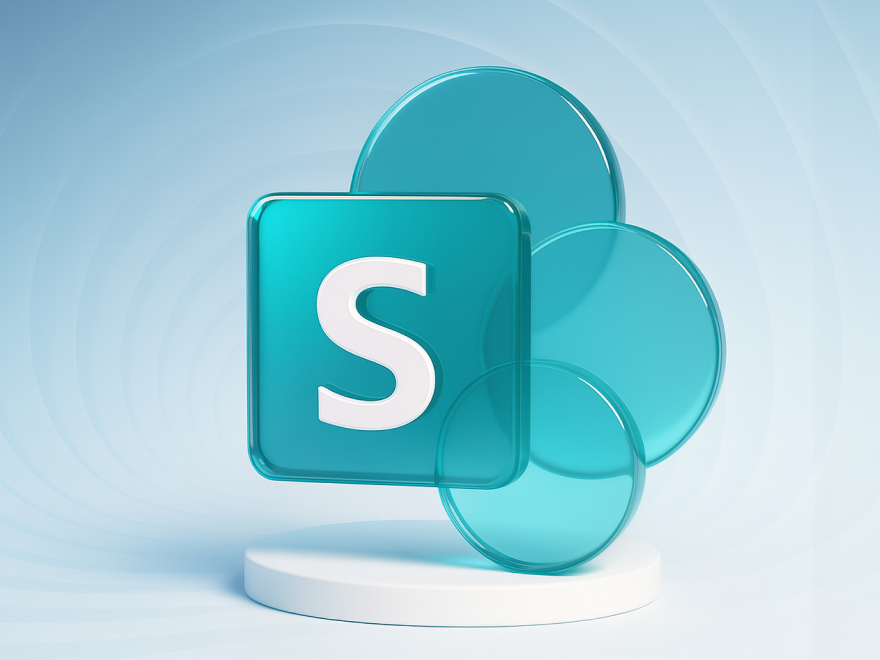



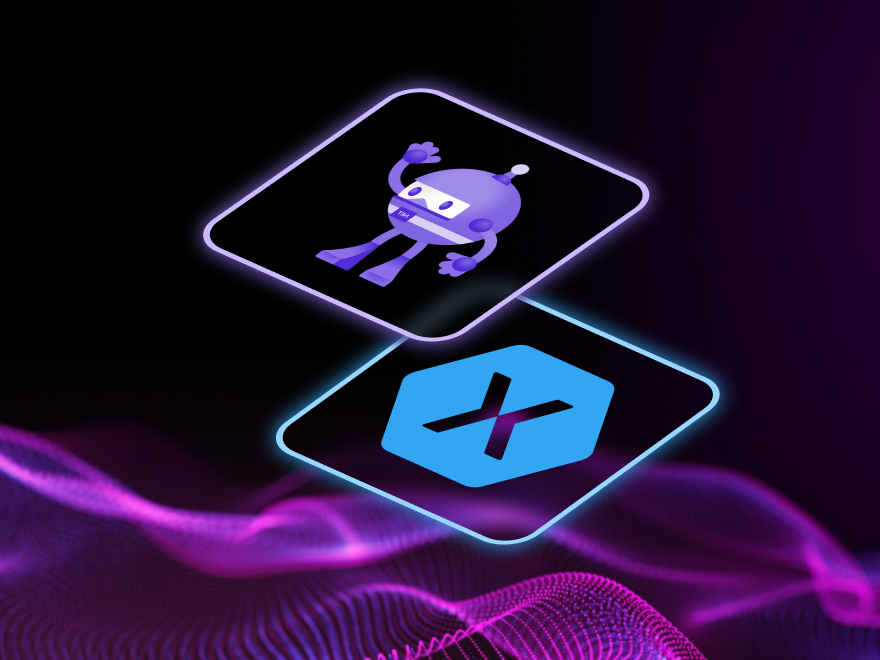



Meldingen din er sendt.
Vi behandler forespørselen din og kontakter deg så snart som mulig.

Ved å registrere deg godtar du vår Retningslinjer for personvern, inkludert bruk av informasjonskapsler og overføring av dine personopplysninger.